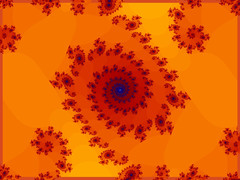Paradoxes are common in both cosmology and in theology. Indeed, this shared quality demonstrates how these two seemingly diverse endeavors are really quite similar, if not two sides of the same coin.
A photon can act like either a wave or a particle depending on what is being tested, or what question is being asked.
Relativity and Quantum Mechanics both are needed to describe the universe, and yet these two views of the cosmos cannot live together in harmony. Relativity describes the very large, while Quantum Mechanics describes the very small. These theories clash in such arenas as black holes, where very large massed converge in very small spaces causing the mathematics to break down.
Matter can be thought of as frozen or congealed energy. The rock in your hand feels solid and permanent, but is really only a lump of frozen energy. And it is not permanent at all, but ephemeral. One common understanding of dark energy is that all atoms will be eventually ripped apart and normal, baryonic matter will be no more.
The speed of light is the cosmic speed limit, except that this speed limit does not exist for space itself. The theory of Inflation, first proposed by Alan Guth, requires that at the Big Bang space expanded vastly faster than the speed of light. This means that the universe is vastly larger than our horizon. We can see 13.5 billion light years in any direction, because that is the age of the universe and is as far back in time as we can see. But if we could stand at that horizon, we could see an additional 13.5 billion years further on. Our Universe seems to be paradoxically both bounded and boundless.
Even our Universe may not be all that there is. String Theory and M (or ‘Brane) theory suggest that our Universe is not alone. Rather, the image of our Universe is more like one soap-bubble among countless others.
Theology is impossible without paradoxical thinking. Jesus is fully human and fully divine. Unless a believer can fully hold to these paradoxical understandings then they have not understood the incarnation and what it means.
The Holy Bible was written over some 1,400 years by hundreds of human hands. They represent many different viewpoints and cultural epochs. They record the spiritual saga of the Jews and the early Christians, written from a human perspective. And yet somehow there is divine inspiration to be found within.
The Universe was created according to the laws of science. It was formed from the Big Bang, evolved according to inflation, general relativity, special relativity, quantum mechanics, plate tectonics, evolution, genetic mutation, chaos theory, random chance, fractals and a host of other scientific
principles, known and unknown. And yet somehow it was created by God and filled with God’s logos, or divine order that permeates all things.
A good example of this divine logos is the concept of fractals. Fractal math describes how large items can be structured by simple repeating patterns. The architecture of a leaf is a fractal pattern with cells and veins growing out of the repetition of simple patterns. The arrangement of the limbs and branches of a tree are also derived from fractal patterns. Fractal patterns can create vast and elegant constructions from a few simple codes. This coding can be computer code or DNA. Coastal redwood trees can grow to over 360 feet in height. One of the joys of living in Northern California is walking through forests of these giant trees that grow to form living cathedrals. And yet, through the miracle of fractal algorithms, the seeds of these magnificent trees are no bigger than a grain of rice.
John Calvin, the founder of the Reformed Tradition, wrote that to study the creation is to study the creator. His words provided the theological foundation for all of modern science. Cosmology links science and theology.
We live in a Universe that is beyond all comprehension. And yet, the paradox is that we can learn to comprehend it. And that might be the ultimate paradox.
Filed under: Church History & Theology, Cosmology Tagged: Bible, Big Bang, cosmology, creation, Divine, Fractal, God, John Calvin, paradox, Quantum Mechanics, Redwoods, Scripture, String theory, Theology, Universe


